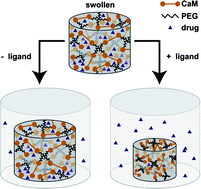Dynamic hydrogels have played a central role in the development of devices for controlled drug delivery. Previous drug delivery systems based on dynamic hydrogels have typically responded to non-specific, physicochemical stimuli such as heat, light, and pH. Here we describe an alternative approach to develop dynamic, drug-releasing materials based on a protein conformational change induced by a specific biochemical ligand. We report a synthetic process in which a dynamic protein, calmodulin (CaM), was efficiently reacted with poly(ethylene glycol) diacrylate (PEGDA) molecules. The resulting PEG-CaM-PEG conjugates were then photo-crosslinked to form dynamic hydrogels. The initial composition of PEG-CaM-PEG conjugates affected hydrogel formation and hydrogel dynamic properties. Specifically, various hydrogels prepared with combinations of PEG-CaM-PEG and PEGDA molecules underwent volume decreases of 10%–80% relative to their initial volume when exposed to the biochemical ligand trifluoperazine (TFP). This decrease in volume can be attributed to calmodulin's well-characterized hinge motion upon ligand binding. PEG-CaM-PEG hydrogels released a larger amount of VEGF more rapidly when exposed to the TFP ligand, indicating that the ligand-induced collapse in hydrogel volume could be translated into a significant change in therapeutic growth factor release. The increase in the amount of VEGF was dependent on: (i) the initial amount of VEGF absorbed into the hydrogel; (ii) the magnitude of dynamic volume change; and (iii) the timing of hydrogel exposure to TFP. This study provides a first demonstration that a protein conformational change can be used to modulate release of therapeutic proteins from hydrogels. There are over 200 proteins that undergo well characterized conformational changes, and so this mechanism could be broadly applicable in controlled drug delivery applications.

You have access to this article
 Please wait while we load your content...
Something went wrong. Try again?
Please wait while we load your content...
Something went wrong. Try again?


 Please wait while we load your content...
Please wait while we load your content...